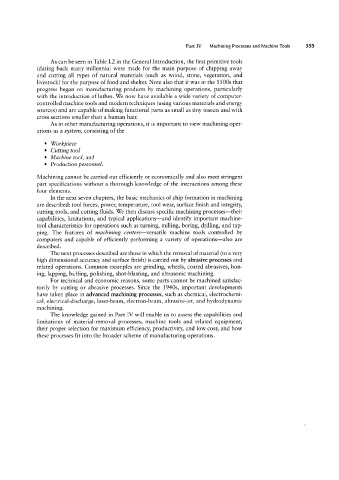Page 574 - 04. Subyek Engineering Materials - Manufacturing, Engineering and Technology SI 6th Edition - Serope Kalpakjian, Stephen Schmid (2009)
P. 574
Part IV Machining Processes and Machine Tools
As can be seen in Table 1.2 in the General Introduction, the first primitive tools
(dating back many millennia) were made for the main purpose of chipping away
and cutting all types of natural materials (such as wood, stone, vegetation, and
livestock) for the purpose of food and shelter. Note also that it was in the 1500s that
progress began on manufacturing products by machining operations, particularly
with the introduction of lathes. We now have available a wide variety of computer-
controlled machine tools and modern techniques (using various materials and energy
sources) and are capable of making functional parts as small as tiny insects and with
cross sections smaller than a human hair.
As in other manufacturing operations, it is important to view machining oper-
ations as a system, consisting of the
° Wor/apiece
° Cutting tool
° Mac/vine tool, and
° Production personnel.
Machining cannot be carried out efficiently or economically and also meet stringent
part specifications without a thorough knowledge of the interactions among these
four elements.
In the next seven chapters, the basic mechanics of chip formation in machining
are described: tool forces, power, temperature, tool wear, surface finish and integrity,
cutting tools, and cutting fluids. We then discuss specific machining processes-their
capabilities, limitations, and typical applications-and identify important machine-
tool characteristics for operations such as turning, milling, boring, drilling, and tap-
ping. The features of machining centers-versatile machine tools controlled by
computers and capable of efficiently performing a variety of operations--also are
described.
The next processes described are those in which the removal of material (to a very
high dimensional accuracy and surface finish) is carried out by abrasive processes and
related operations. Common examples are grinding, wheels, coated abrasives, hon-
ing, lapping, buffing, polishing, shot-blasting, and ultrasonic machining.
For technical and economic reasons, some parts cannot be machined satisfac-
torily by cutting or abrasive processes. Since the 19405, important developments
have taken place in advanced machining processes, such as chemical, electrochemi-
cal, electrical-discharge, laser-beam, electron-beam, abrasive-jet, and hydrodynamic
machining.
The knowledge gained in Part IV will enable us to assess the capabilities and
limitations of material-removal processes; machine tools and related equipment;
their proper selection for maximum efficiency, productivity, and low cost; and how
these processes fit into the broader scheme of manufacturing operations.

